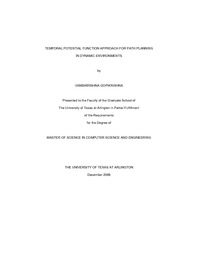
ATTENTION: The works hosted here are being migrated to a new repository that will consolidate resources, improve discoverability, and better show UTA's research impact on the global community. We will update authors as the migration progresses. Please see MavMatrix for more information.
Show simple item record
| dc.contributor.author | Gopikrishna, Vamsikrishna | en_US |
| dc.date.accessioned | 2009-09-16T18:20:06Z | |
| dc.date.available | 2009-09-16T18:20:06Z | |
| dc.date.issued | 2009-09-16T18:20:06Z | |
| dc.date.submitted | January 2008 | en_US |
| dc.identifier.other | DISS-10075 | en_US |
| dc.identifier.uri | http://hdl.handle.net/10106/1820 | |
| dc.description.abstract | A Dynamic environment is one in which either the obstacles or the goal or both are in motion. In most of the current research, robots attempting to navigate in dynamic environments use reactive systems. Although reactive systems have the advantage of fast execution and low overheads, the tradeoff is in performance in terms of the path optimality. Often, the robot ends up tracking the goal, thus following the path taken by the goal, and deviates from this strategy only to avoid a collision with an obstacle it may encounter. In a path planner, the path from the start to the goal is calculated before the robot sets off. This path has to be recalculated if the goal or the obstacles change positions. In the case of a dynamic environment this happens often. One method to compensate for this is to take the velocity of the goal and obstacles into account when planning the path. So instead of following the goal, the robot can estimate where the best position to reach the goal is and plan a path to that location. In this thesis, we propose such a method for path planning in dynamic environments. The proposed method uses a potential function approach that considers time as a variable when calculating the potential value. This potential value of a particular location and time value indicates the probability that a robot will collide with an obstacle, assuming that the robot executes a random walk from that location and that time onwards. Thus the robot plans a path by extrapolating the object's motion using current velocities and by calculating the potential values up to a look-ahead limit that is determined by calculating the minimum path length using connectivity evaluation and then determining the utility of expanding the look-ahead limit beyond the minimum path length. The method is fast, so the path can be re-planned with very little overhead if the initial conditions change at execution time. The thesis will discuss how the potential values are calculated and how a suitable look-ahead limit is decided. Finally the performance of the proposed method is analyzed in a simulated environment. | en_US |
| dc.description.sponsorship | Huber, Manfred | en_US |
| dc.language.iso | EN | en_US |
| dc.publisher | Computer Science & Engineering | en_US |
| dc.title | Temporal Potential Function Approach For Path Planning In Dynamic Environments | en_US |
| dc.type | M.S. | en_US |
| dc.contributor.committeeChair | Huber, Manfred | en_US |
| dc.degree.department | Computer Science & Engineering | en_US |
| dc.degree.discipline | Computer Science & Engineering | en_US |
| dc.degree.grantor | University of Texas at Arlington | en_US |
| dc.degree.level | masters | en_US |
| dc.degree.name | M.S. | en_US |
| dc.identifier.externalLink | http://www.uta.edu/ra/real/editprofile.php?onlyview=1&pid=190 | |
| dc.identifier.externalLinkDescription | Link to Research Profiles | |
Files in this item
- Name:
- Gopikrishna_uta_2502M_10075.pdf
- Size:
- 1.240Mb
- Format:
- PDF
This item appears in the following Collection(s)
Show simple item record


